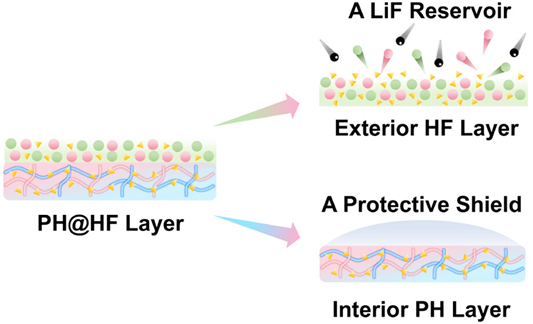Title: Constructing an Artificial Interface as a Bifunctional Promoter for the Li Anode and the NCM Cathode in Lithium Metal Batteries
Authors: Huayu Huang, Shishi Liu, Yuxiang Xie, Junke Liu, Chenguang Shi, Miaolan Sun, Hao Peng, Jian Lan, Ya-Ping Deng*, Ling Huang*, Shi-Gang Sun*
Abstract: The bottleneck of Li metal batteries toward practical applications lies at inferior cyclability as well as Li dendrite issues. As a promising solution, an interface engineering strategy is proposed herein for the Li anode through constructing a hybrid artificial interface. It is assembled onto the Li anode using photocontrolled free radical polymerization (photo-CRP) of polyethylene glycol diacrylate-hexafluorobutyl methacrylate and hexafluorobutyl methacrylate-trifluoroethyl carbonate (PEGDA-HFMBA@HFMBA-FEMC or PH@HF layer). Among such hybrid interfaces, the interior layer of PEGDA-HFMBA exists as a protective shield with flexibility and fracture resistance, while the exterior layer of HFMBA-FEMC plays a role as a LiF reservoir to promote Li mass transfer and its even electrodeposition. In the meantime, some excess HFMBA and FEMC monomers further dissolve into the electrolyte as molecular additives, followed by in situ generation of a thin and robust LiF-rich cathode electrolyte interface (CEI). With the resulting Li anode, Li/NCM811 full cells showcase multifold cyclability amplification in comparison to cells using Bare-Li, covering durable cyclability with a capacity retention of 81.8% after 400 cycles. When the cutoff voltage is elevated to 4.5 V or the working temperature is elevated to 45 °C, the cells still maintain a stable operation for extending 300 cycles.

Full-Link: https://pubs.acs.org/doi/10.1021/jacs.4c11012